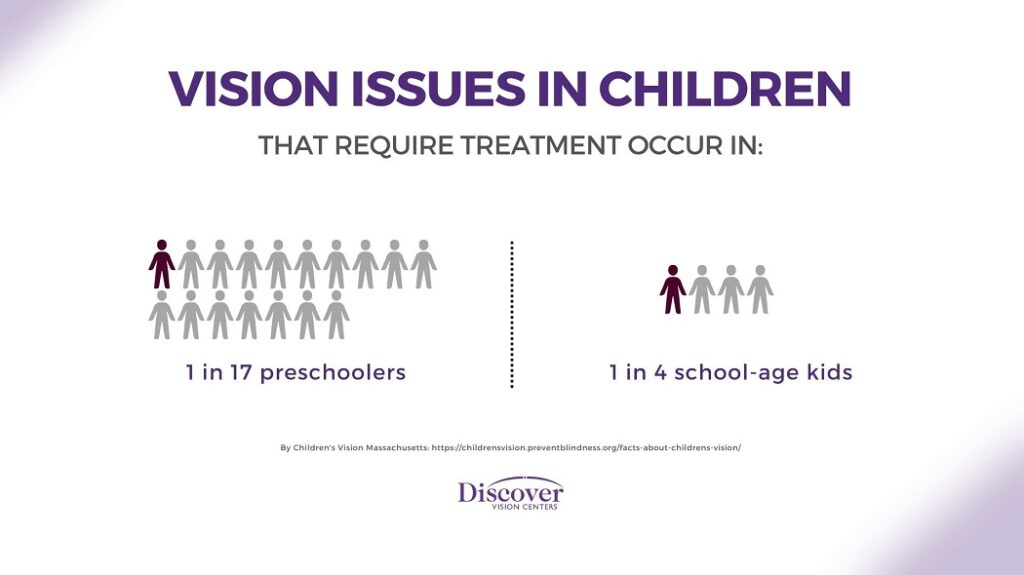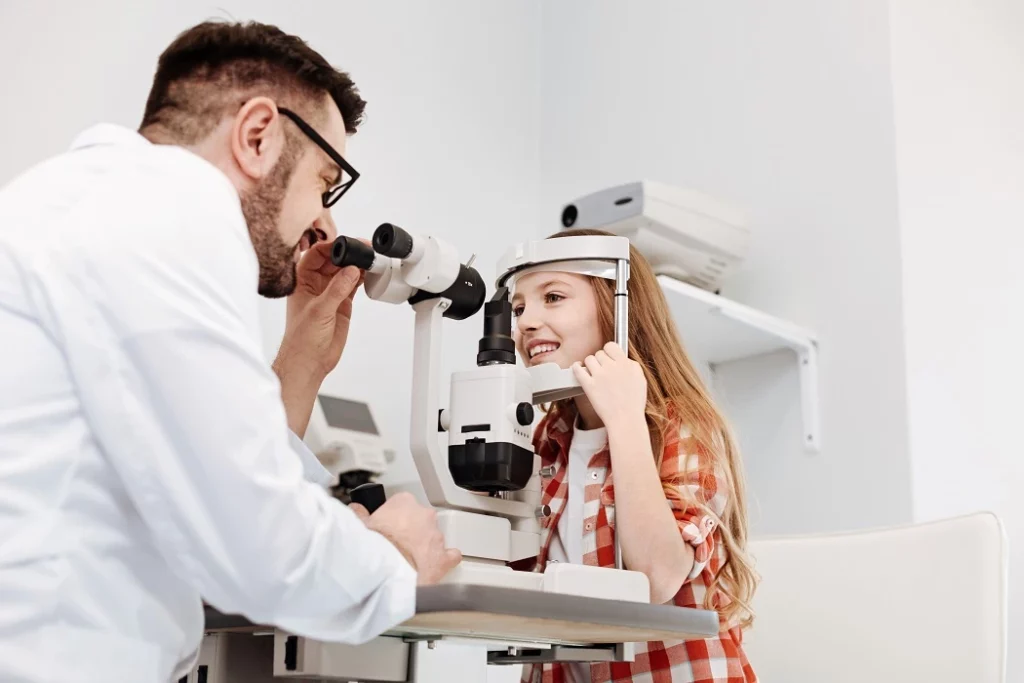
Updated: February 09, 2024
Clear vision is crucial for children’s growth, development, and quality of life, and regular eye exams are essential for early detection and treatment of vision problems. Discover Vision Centers has served the Kansas City region for five decades, and our experienced team can diagnose common eye conditions and prescribe corrective lenses or glasses. We prioritize eye health for all ages, including children, and are committed to treating your child’s vision issues throughout their life.

From birth to young adulthood, it’s important to monitor your child’s developing vision to keep their eyes healthy and address any concerns as quickly as possible.
In the earliest months, newborns are still developing their vision. They primarily focus on nearby objects and gradually begin following interesting items with their eyes. You’ll need to watch for chronic eye discharge and signs of conjunctivitis (pinkeye).
Around 6 months of age, babies should have their first vision screening. They should maintain eye contact, track moving objects, and avoid frequent eye misalignment. Early screenings by an eye doctor are important in ensuring developing vision stays on track.
As toddlers grow, their visual abilities improve and their hand-eye coordination is enhanced. Look for signs of conditions like strabismus or amblyopia, and promptly consult an optometrist if needed. Some kids may also exhibit refractive issues that need early diagnosis and treatment.

School-age children face increased visual demands, like reading and writing. Clear vision up close and at a distance is vital, along with strong hand-eye coordination. Refractive errors are common in this age group, often managed with glasses or contact lenses. Be aware of signs of potential eye issues such as excessive blinking, discomfort, or conjunctivitis.
By the teenage years, most early eye problems have been addressed. Occasionally, teens may be diagnosed with refractive errors or encounter eye infections. Scratched corneas from foreign objects or poor contact lens hygiene are potential concerns. It’s important to get them regular eye check-ups during this time.
In young adulthood, most vision issues have been identified. Environmental factors become key considerations, such as digital eye strain from extensive computer use or sun exposure. Encourage breaks, UV protection with sunglasses, and protective eyewear for activities with injury risks to maintain lifelong eye health.
The recommended schedule for regular eye exams by age is as follows:
However, the frequency of eye exams may vary based on individual circumstances and risk factors. Children with specific factors such as a history of premature birth, family history of eye diseases, or signs of vision issues may need more frequent and more comprehensive eye examinations. Always stay attentive to your child’s unique needs and follow the guidance of their eye doctor to ensure their eyes remain healthy and their vision is at its best.
| Eye Condition/Issue | Symptoms | Causes | Treatment |
|---|---|---|---|
| Nearsightedness (Myopia) | Blurred vision when looking at a distance, squinting, eye strain | Genetic predisposition, environmental factors, prolonged near work | Corrective eyeglasses, contact lenses, orthokeratology, refractive surgery |
| Farsightedness (Hyperopia) | Blurred vision when focusing on close objects, eye strain, headaches | Genetic factors, eye shape, age | Prescription eyeglasses, contact lenses, refractive surgery |
| Astigmatism | Blurred or distorted vision, eye strain, headaches | Irregular shape of the cornea or lens, genetic factors | Eyeglasses, contact lenses, orthokeratology, refractive surgery |
| Strabismus (Crossed Eyes) | Misalignment of the eyes, double vision, eye strain | Imbalance in eye muscles, genetic factors | Prescription eyeglasses, eye patching, eye muscle exercises, surgical intervention |
| Amblyopia (Lazy Eye) | Reduced vision in one eye, squinting, difficulty with depth perception | Eye misalignment, unequal focusing ability | Eye patching, eyeglasses, vision therapy |
| Color Blindness | Difficulty distinguishing colors, confusion with certain hues | Genetic inheritance, eye injuries, specific medical conditions | No cure, specialized glasses for color correction, assistive technologies |
| Conjunctivitis (Pink Eye) | Redness, itching, discharge, tearing | Bacterial or viral infections, allergies, irritants | Antibiotic eye drops, antiviral medications, warm compresses |
| Dry Eye Syndrome | Dryness, burning or stinging sensations, redness | Reduced tear production, poor tear quality | Artificial tears, lifestyle modifications, prescription medications |
| Computer Vision Syndrome | Eye strain, headaches, dry eyes | Prolonged screen time, inadequate lighting, poor posture | Regular breaks, ergonomic adjustments, artificial tears |
| Retinoblastoma | White pupil reflection, squinting, eye pain | Genetic mutations, hereditary factors | Chemotherapy, radiation therapy, enucleation (eye removal) |
Some frequently encountered vision issues in children include:
If you notice signs like squinting, eye rubbing, difficulty concentrating, or complaints of headaches, especially after engaging in school-related tasks, you’ll want to schedule an appointment with an eye doctor. A qualified eye doctor can assess your child for these conditions and other vision problems and recommend ideal treatment options if necessary. Early intervention can make a huge difference in ensuring your child’s visual health and overall quality of life.

Strabismus (misaligned eyes) and nystagmus (involuntary eye movements) are examples of pediatric eye disorders that can sometimes be improved with surgery on the eye muscles.
However, not all eye surgeries are appropriate for young children. For example, refractive procedures like LASIK are generally delayed until adulthood. This is because a child’s vision is still changing as their eyes develop. So even after surgical correction, their vision may continue to shift.
The risks and benefits must be carefully weighed; procedures done too early carry the risk of vision changes later on. Eye doctors will conduct a specialized assessment to determine if and when surgery should be considered for a child’s eye condition.
Ensuring children with specific eye conditions have the right eyeglasses can make a world of difference in their vision. However, convincing kids to wear glasses consistently can be challenging. We’ve outlined some practical strategies to ease the process:
In some cases, contact lenses may be ideal for older kids and teens, especially those involved in sports or those uncomfortable with glasses. Make sure they have proper education on contact lens usage and hygiene so they can wear them safely and effectively.

Our team has outlined some valuable tips to protect kids’ eyes:
Even if you take the above preventive measures, regular eye check-ups are important. A routine eye exam, such as the ones offered by our team at Discover Vision Centers in Kansas City, MO, can detect and address any potential vision problem early. We’ll help provide your child with the best possible care.
Take the initiative today, schedule an eye exam for your child, and give him or her the gift of a bright and healthy future!